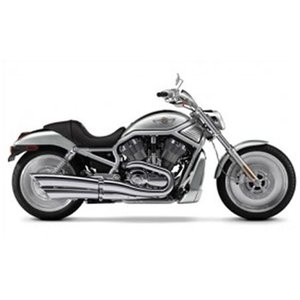Harley-Davidson V-Rod (2002-2006): A Radical Departure That Redefined Cruisers
Introduction
When Harley-Davidson unveiled the V-Rod in 2001 as a 2002 model, it sent shockwaves through the motorcycle world. Here was a Harley that looked like it rode straight out of a cyberpunk fever dream, with liquid cooling, overhead cams, and a Porsche-engineered engine. The VRSCA V-Rod (2002-2006) wasn’t just another cruiser—it was Milwaukee’s bold answer to the sportier, faster bikes encroaching on its territory. For riders who wanted Harley’s brand cachet but craved modern performance, the V-Rod became an instant icon. After swinging a leg over a pristine 2006 example, it’s clear why this machine still turns heads two decades later.
Design: Futuristic Muscle Meets Milwaukee DNA
The V-Rod’s design language was revolutionary for Harley. Gone were the retro curves and chrome-drenched nostalgia; instead, riders got a hydroformed perimeter frame that looked like exposed vertebrae, cradling the 1,131cc V-twin. The radiator shrouds—a first for Harley—integrated twin vortex scoops that gave the bike an aggressive, technical profile.
Key design highlights:
- Low-slung stance: A seat height of 660 mm (26 inches) let even shorter riders plant both feet firmly, while the sculpted seat pushed you into a leaned-forward riding position atypical for cruisers.
- Industrial-chic details: The anodized aluminum frame finishes (available in silver, charcoal, or two-tone schemes) and slash-cut exhausts screamed factory-built custom.
- Color drama: Options like Black Cherry Pearl, Deep Cobalt, and two-tone Luxury Teal/Brilliant Silver made it stand out in parking lots dominated by blacked-out Softails.
The 2004-2006 models added touring-friendly touches like detachable windshields and studded leather saddlebags, blending futurism with practicality.
Performance: Porsche’s Heart in Harley’s Body
Harley’s collaboration with Porsche resulted in the Revolution engine—a DOHC, liquid-cooled 60-degree V-twin that revved to 9,000 RPM. This wasn’t your grandpa’s air-cooled shovelhead.
Power Delivery
- 115-117 HP (86-88 kW): Peaking at 8,250 RPM, the V-Rod outpaced most cruisers of its era. The 2005-2006 models upped torque to 105 Nm (77.4 lb-ft), making highway overtakes effortless.
- Fuel injection: The ESPFI system delivered crisp throttle response, a stark contrast to carbureted Harleys that demanded choke fiddling on cold mornings.
- Exhaust note: Deeper and smoother than a Sportster’s rasp, but lacking the potato-potato cadence—a tradeoff purists debated endlessly.
Riding the V-Rod feels like piloting a muscle car. The engine pulls linearly from 3,000 RPM, with a surge at 6,000 RPM that pins you to the seat. At 140 km/h (87 mph), the bike remains composed, though the small 14-18.9 L (3.7-5.0 gal) fuel tank reminds you to plan gas stops.
Handling: Not Your Average Cruiser
Harley cruisers aren’t known for cornering prowess, but the V-Rod’s 49mm telescopic forks and stiff chassis let it carve twisties with sportbike-like confidence.
- Wheelbase: 1,710-1,715 mm (67.3-67.5 inches)—shorter than a Fat Boy, aiding agility.
- Tires: Later models swapped the stock 150/80-B16 rear for a grippy 180/55-ZR18, improving lean angles.
- Brakes: Dual 292mm front discs (post-2002) provided stopping power that matched the engine’s gusto.
Ground clearance is limited at 127-142 mm (5.0-5.6 inches), so scraping pegs is inevitable during spirited rides. Still, the bike feels surprisingly neutral mid-corner, with the wide handlebar offering leverage to adjust lines.
Competition: The V-Rod’s Arena
In the early 2000s power cruiser segment, the V-Rod faced fierce rivals:
- Yamaha VMAX (1999-2007):
- Raw power: 145 HP vs. V-Rod’s 115 HP
- Handling: Heavier steering and dated air cooling
-
Verdict: The VMAX was a dragstrip king but lacked the V-Rod’s polish for daily riding.
-
Honda VTX1800 (2002-2008):
- Torque monster: 165 Nm (122 lb-ft) vs. V-Rod’s 105 Nm
- Weight penalty: 326 kg (719 lbs) made it feel ponderous
-
Verdict: The VTX appealed to traditionalists; the V-Rod targeted futurists.
-
Suzuki Boulevard M109R (2006-):
- Styling: Bold, with a 1783cc V-twin
- Ergonomics: Higher seat (700 mm/27.5 in) less accessible to shorter riders
- Verdict: The Suzuki matched the V-Rod’s aggression but arrived late to the party.
The V-Rod carved a niche by blending Harley’s customization culture with Euro-style engineering—a bridge between Milwaukee and Munich.
Maintenance: Keeping the Revolution Alive
Owning a V-Rod requires attention to its unique needs:
- Oil changes:
- Use SAE 20W-50 (4.2 L/4.4 qt with filter). Avoid cheap oils—this engine runs hot.
-
MOTOPARTS.store recommendation: Lucas High-Zinc Synthetic.
-
Valve adjustments:
- Intake: 0.22 ± 0.025 mm (0.0087 ± 0.001 in)
- Exhaust: 0.32 ± 0.025 mm (0.0126 ± 0.001 in)
-
Check every 16,000 km (10,000 mi).
-
Cooling system:
- Use ethylene glycol-based coolant mixed 50/50 with distilled water.
-
Flush every 48,000 km (30,000 mi).
-
Belt drive:
- Inspect for cracks/tears. Replace every 64,000 km (40,000 mi).
-
Upgrade option: Gates Poly Chain GT Carbon.
-
Tire pressure:
- Front: 2.5 bar (36 psi)
- Rear: 2.6-2.7 bar (38-39 psi)
Common issues:
- Radiator leaks: Check hose clamps annually.
- Stator failures: Upgrade to a high-output stator if adding accessories.
Conclusion: The Legacy of a Maverick
The V-Rod was Harley’s moonshot—a bike that dared to alienate traditionalists to capture a new generation. While discontinued in 2017, the 2002-2006 models remain the purest expression of its vision. Riding one today is a reminder that innovation, not just tradition, drives motorcycling forward.
For V-Rod owners, MOTOPARTS.store offers everything from performance cams to custom mirrors, ensuring your Revolution-powered machine stays ahead of its time. Aftermarket support has never been stronger—proof that even Harley’s black sheep can age into legends.



















